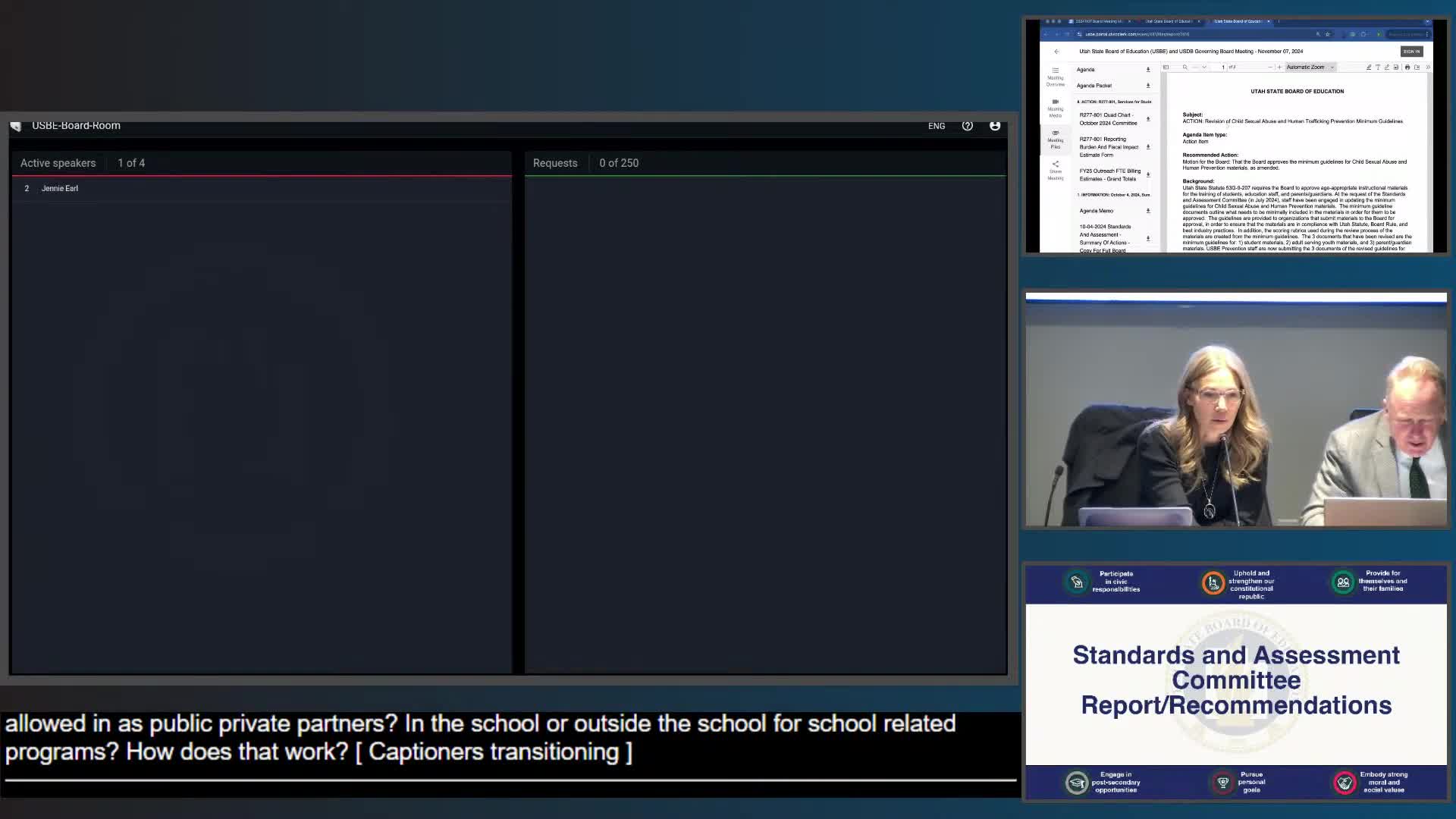State board adopts tighter guidance for child abuse and human-trafficking prevention materials after debate over outside resources
November 08, 2024 | Utah State Board of Education, Utah Education, State Agencies, Organizations, Utah Executive Branch, Utah
This article was created by AI summarizing key points discussed. AI makes mistakes, so for full details and context, please refer to the video of the full meeting. Please report any errors so we can fix them. Report an error »

The Utah State Board of Education approved minimum guidelines on Friday for instructional materials and training to prevent child abuse and human trafficking, but only after clarifying edits and a contentious discussion over which outside resources should be recommended.
The board voted to adopt a revised draft of the materials guidance for parents, guardians and school staff. The measure removes language that presented "myths and misconceptions" (research shows listing myths can reinforce them) and eliminates a separate "additional resources" appendix that had listed third-party hotlines and national programs. In a prior amendment, board members moved the SafeUT crisis app from the secondary resources into the main, recommended resources list.
Vice Chair Emily Earl, who led the motion to update the guidance, said the aim was to simplify the materials and steer the public and schools to primary, state-trusted supports first. "We do not want to bury caregivers and educators in a long list of links when a rapid, local response is needed," she said.
Opponents urged caution: some board members flagged that removing secondary resources could unintentionally limit options for schools or families. Board Member Claudia Klein unsuccessfully moved to explicitly bar the use of certain outside resources; that amendment failed 14-1. In the final tally the board approved the guidance 13-2, with dissenting votes from Board Members Boggess and Klein.
Process and next steps: Board staff will implement technical edits to remove the myths/misconceptions framing and to update resource headings. The final guidance will be posted online and shared with districts and charter schools.
What the guidance does and does not do: It sets minimum content requirements for prevention curricula and points educators toward state-run supports; it does not, by itself, require districts to adopt a specific vendor or curriculum. It also does not create new statutory duties; if the legislature wishes to change where or how private-school records or vendor lists are managed, that would be a separate step.
Board members emphasized the state law requiring instructional materials to be approved by the board before use in schools. Several members urged staff to keep the guidance under regular review and to add plain-English labels ("facts about abuse," "how to get help") so caregivers and school staff can find help quickly.
The board voted to adopt a revised draft of the materials guidance for parents, guardians and school staff. The measure removes language that presented "myths and misconceptions" (research shows listing myths can reinforce them) and eliminates a separate "additional resources" appendix that had listed third-party hotlines and national programs. In a prior amendment, board members moved the SafeUT crisis app from the secondary resources into the main, recommended resources list.
Vice Chair Emily Earl, who led the motion to update the guidance, said the aim was to simplify the materials and steer the public and schools to primary, state-trusted supports first. "We do not want to bury caregivers and educators in a long list of links when a rapid, local response is needed," she said.
Opponents urged caution: some board members flagged that removing secondary resources could unintentionally limit options for schools or families. Board Member Claudia Klein unsuccessfully moved to explicitly bar the use of certain outside resources; that amendment failed 14-1. In the final tally the board approved the guidance 13-2, with dissenting votes from Board Members Boggess and Klein.
Process and next steps: Board staff will implement technical edits to remove the myths/misconceptions framing and to update resource headings. The final guidance will be posted online and shared with districts and charter schools.
What the guidance does and does not do: It sets minimum content requirements for prevention curricula and points educators toward state-run supports; it does not, by itself, require districts to adopt a specific vendor or curriculum. It also does not create new statutory duties; if the legislature wishes to change where or how private-school records or vendor lists are managed, that would be a separate step.
Board members emphasized the state law requiring instructional materials to be approved by the board before use in schools. Several members urged staff to keep the guidance under regular review and to add plain-English labels ("facts about abuse," "how to get help") so caregivers and school staff can find help quickly.
View full meeting
This article is based on a recent meeting—watch the full video and explore the complete transcript for deeper insights into the discussion.
View full meeting

